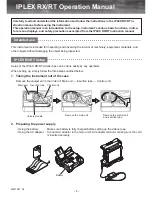
,,,,,,,,,,,,,,,,
,,,,,,,,,,,,,,,,
QQQQQQQQQQQQQQQQ
QQQQQQQQQQQQQQQQ
¢¢¢¢¢¢¢¢¢¢¢¢¢¢¢¢
¢¢¢¢¢¢¢¢¢¢¢¢¢¢¢¢
42
Digital Effects
Harmony
When HARMONY is on, playing single notes or chords on the right-hand section
of the keyboard produces automatic harmony matched to the accompaniment chords
(AUTO ACCOMPANIMENT must be on). Harmony is applied to the R1 voice. When
chords are played the harmony is based on the last note played (i.e. last-note priority).
The PSR-530 has 16 different harmony types, as listed below.
2
Set the DSP Return Level
Use the [–] and [+] buttons, number buttons, or data dial to set the desired DSP
return level (the current return level value appears to the left of “DspRtnLv” on the
display). The range is from “0” to “127”. The higher the value the greater the return
level.
DspRtnLv
064
No.
Type
Description
1
Duet
This harmony type produces a duophonic melody with the second voice below the melody
line.
2
Trio
This harmony type generates two voices in addition to the melody voice.
3
4 Part
Three harmony notes are generated to produce a four-note chord.
4
4 Part Jazz
Similar to the preceding type, but depending on the chords played this type will
sometimes produce a more colorful sound.
5
Country
Similar to Duet, but the second voice is above the melody line.
6
Octave
One note is added an octave below the melody.
7
Tremolo
The note(s) pressed and held is(are) repeatedly played at the preset tempo.
8
Tremolo Duet
Combination of Tremolo and Duet; produces a duophonic melody with two voices played
alternately.
DSP Return Level
The DspRtnLv (DSP Return Level) parameter sets the amount of DSP effect
returned from the DSP effect stage, thus making it possible to adjust the degree of DSP
effect applied to the overall sound.
1
Select the Digital Effect “DspRtnLv” Function
Use the MENU [
▲
] and [
▼
] buttons to move the triangular indicator in the display
next to “DIGITAL EFFECT”, then use the SUB MENU [
▲
] and [
▼
] buttons to select
“DspRtnLv”.
















































